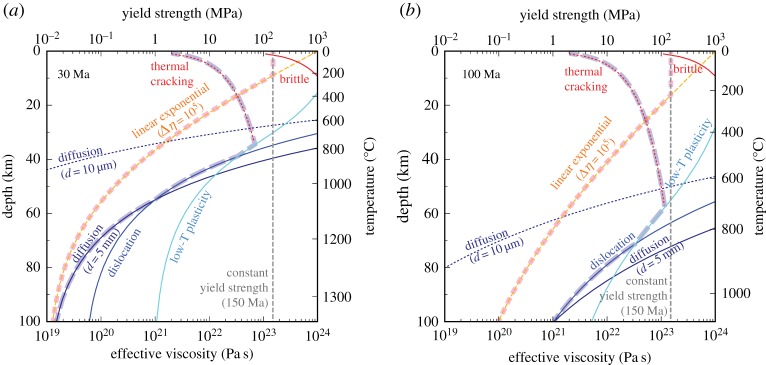Figure 7.
Hypothetical yield strength profiles for present-day oceanic lithosphere at the seafloor age of (a) 30 Ma and (b) 100 Ma. Only the top 100 km is shown, and the assumed thermal structure, based on half-space cooling with the initial temperature of 1350°C, is indicated on the right axis. Yield strength is calculated assuming the geological strain rate of 10−15 s−1, so the yield strength of 1 GPa corresponding to the effective viscosity of 1024 Pa s. The effect of thin crustal layer is ignored, and deformation mechanisms considered here include: (1) diffusion creep with the activation energy of 300 kJ mol−1 and the grain size exponent of 2, with the reference viscosity of 1019 Pa s at 1350°C and the grain size of 5 mm, (2) dislocation creep with the activation energy of 600 kJ mol−1 and the stress exponent of 3, with the reference viscosity of 1019 Pa s at 1350°C and the deviatoric stress of 0.1 MPa, (3) low-temperature plasticity based on the reanalysis of the experimental data of Mei et al. [123] by Jain et al. [124], with the exponents of p = 1 and q = 2, (4) linear exponential viscosity with the total viscosity contrast of 105, (5) brittle strength with the friction coefficient of 0.8 and with optimal thrust faulting [125] and (6) brittle strength with the effective friction coefficient of 0.03 to emulate the effect of thermal cracking [126]. Shown for comparison is the constant yield strength of 150 MPa, which is a typical value used in numerical simulation studies. Diffusion creep with the grain size of 10 mm is shown to illustrate the efficacy of grain-size reduction; this weakening mechanism is not effective in the cold part of lithosphere. Thick dashed lines trace two contrasting cases: case A (pink, short-dashed) for the combination of linear exponential viscosity with constant yield strength, and case B (blue, long-dashed) for the combination of more realistic ductile deformation mechanisms and thermal cracking. These cases are different by up to two orders of magnitudes over the bulk of lithosphere.

